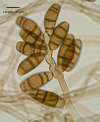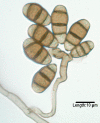Melanized fungi in human disease
- PMID: 20930077
- PMCID: PMC2952981
- DOI: 10.1128/CMR.00019-10
Melanized fungi in human disease
Erratum in
- Clin Microbiol Rev. 2012 Oct;25(4):720
Abstract
Melanized or dematiaceous fungi are associated with a wide variety of infectious syndromes, including chromoblastomycosis, mycetoma, and phaeohyphomycosis. [corrected]. Many are soil organisms and are generally distributed worldwide, though certain species appear to have restricted geographic ranges. Though they are uncommon causes of disease, melanized fungi have been increasingly recognized as important pathogens, with most reports occurring in the past 20 years. The spectrum of diseases with which they are associated has also broadened and includes allergic disease, superficial and deep local infections, pneumonia, brain abscess, and disseminated infection. For some infections in immunocompetent individuals, such as allergic fungal sinusitis and brain abscess, they are among the most common etiologic fungi. Melanin is a likely virulence factor for these fungi. Diagnosis relies on careful microscopic and pathological examination, as well as clinical assessment of the patient, as these fungi are often considered contaminants. Therapy varies depending upon the clinical syndrome. Local infection may be cured with excision alone, while systemic disease is often refractory to therapy. Triazoles such as voriconazole, posaconazole, and itraconazole have the most consistent in vitro activity. Further studies are needed to better understand the pathogenesis and optimal treatment of these uncommon infections.
Figures






















References
-
- Abliz, P., K. Fukushima, K. Takizawa, and K. Nishimura. 2004. Identification of pathogenic dematiaceous fungi and related taxa based on large subunit ribosomal DNA D1/D2 domain sequence analysis. FEMS Immunol. Med. Microbiol. 40:41-49. - PubMed
-
- Adam, R. D., M. L. Paquin, E. A. Petersen, M. A. Saubolle, M. G. Rinaldi, J. G. Corcoran, J. N. Galgiani, and R. E. Sobonya. 1986. Phaeohyphomycosis caused by the fungal genera Bipolaris and Exserohilum. A report of 9 cases and review of the literature. Medicine 65:203-217. - PubMed
-
- Adeyemi, O. A., O. Lie, R. Bernstein, N. Gottardi-Littell, K. Muro, D. Patil, and G. A. Noskin. 2007. Woman with multiple brain abscesses. Clin. Infect. Dis. 45:1351-1352:1397-1399. - PubMed
-
- Agarwal, R. 2009. Allergic bronchopulmonary aspergillosis. Chest 135:805-826. - PubMed
Publication types
MeSH terms
Substances
LinkOut - more resources
Full Text Sources
Other Literature Sources
Medical
Miscellaneous

